Directed Energy Deposition-Laser Beam of Semi-Austenitic Precipitation-Hardening Stainless Steel
Abstract
1. Introduction
2. Materials and Methods
3. Results and Discussion
4. Conclusions
- The comparative analysis of the topography images and the average roughness (Ra) values obtained for different powder feed rates in the DED-LB process demonstrated an inverse relationship between the feed rate and the surface roughness. The powder feed rate of 4.7 g/min resulted in lower Ra values than those observed with the rate of 9.2 g/min. This finding suggests that a lower powder feed rate, combined with the employed levels of the other parameters, can provide a more controlled and uniform deposition of the material, minimizing the formation of irregularities and surface defects, such as porosities and cracks.
- The higher powder feed rate, combined with the used levels of laser power and scanning speed, also failed to achieve substrate dilutions above 20%, compromising the integrity of the metallurgical bond between the bead and the substrate. The lower feed rate resulted in dilutions between 15 and 45%, with some parameter combinations reaching values close to 30%.
- EBSD mappings revealed a ferritic–austenitic solidification mode, which is in good agreement with thermodynamic calculations for equilibrium and non-equilibrium solidification. The FCC austenite fraction varied between 36 and 80%, and did not show a clear trend with the studied process parameters. On the other hand, an inverse correlation of the FCC phase fraction was found in relation to the Al content, which, in turn, is dependent on the substrate dilution.
- The combination of a 400 W laser power and 2000 mm/min scanning speed was identified as the optimal set of parameters, resulting in a dilution close to 30%, enough to promote strong metallurgical bonding, and an austenite fraction approaching 80%. Further studies would be required to test the feasibility of converting this high-austenite fraction into highly wear-resistant martensite using low-temperature heat treatments.
- Additionally, the optimization of process parameters, such as the powder feed rate, contributes to more sustainable manufacturing by reducing the consumption of raw materials and energy, minimizing waste generation. Optimization may also enable the DED-LB processing of semi-austenitic precipitation-hardening stainless steels with adjustable microstructures and mechanical properties.
Author Contributions
Funding
Data Availability Statement
Acknowledgments
Conflicts of Interest
References
- Yazar, K.U.; Pawar, S.; Park, K.-S.; Choi, S.-H. Effect of process parameters on the clad morphology, microstructure, microtexture, and hardness of single layer 316 L stainless steel during direct energy deposition. Mater. Charact. 2022, 191, 112148. [Google Scholar] [CrossRef]
- Ma, Z.; Liu, W.; Li, W.; Liu, H.; Lv, Z.; Song, J.; Huang, Y.; Liu, B.; Liu, Y.; Zhang, Y. Optimization of density and surface morphology of SS 316L/IN718 functionally graded thin-walled structures using hybrid prediction-multi-objective optimization method. J. Manuf. Process. 2024, 120, 337–352. [Google Scholar] [CrossRef]
- Barragan, G.A.; Ferreira, R.; Mariani, F.E.; da Silva, E.J.; Coelho, R.T. Study of the surface roughness of a remanufactured bimetallic AISI 1045 and 316L SS part obtained by hybrid manufacturing (DED-HSM). Int. J. Adv. Manuf. Technol. 2022, 117, 1–13. [Google Scholar]
- Chen, Z.; Yang, C. Effect of molten-pool inertia in variable-width arc-based direct energy deposition by regulating parameters. J. Manuf. Process. 2024, 124, 720–732. [Google Scholar] [CrossRef]
- Soyama, H.; Okura, Y. The use of various peening methods to improve the fatigue strength of titanium alloy Ti6Al4V manufactured by electron beam melting. AIMS Mater. Sci. 2018, 5, 1000–1015. [Google Scholar] [CrossRef]
- Reddy, Y.P.; Narayana, K.L.; Mallik, M.K.; Paul, C.P.; Singh, C.P. Experimental evaluation of additively deposited functionally graded material samples—Microscopic and spectroscopic analysis of SS-316L/Co-Cr-Mo alloy. AIMS Mater. Sci. 2022, 9, 653–667. [Google Scholar] [CrossRef]
- Kechagias, J.D. Materials for Additive Manufacturing. AIMS Mater. Sci. 2022, 9, 785–790. [Google Scholar] [CrossRef]
- Bax, B.; Rajput, R.; Kellet, R.; Reisacher, M. Systematic evaluation of process parameter maps for laser cladding and directed energy deposition. Addit. Manuf. 2018, 21, 487–494. [Google Scholar] [CrossRef]
- Sreekanth, S.; Ghassemali, E.; Hurtig, K.; Joshi, S.; Andersson, J. Effect of Direct Energy Deposition Process Parameters on Single-Track Deposits of Alloy 718. Metals 2020, 10, 96. [Google Scholar] [CrossRef]
- Ballésio, S.; Hong, T.L.; Dhondt, M.; Doudard, C.; Szmytka, F. Manufacturing of 2507 super duplex stainless steel by laser powder-directed energy deposition: Process optimization and microstructure analyses. Int. J. Adv. Manuf. Technol. 2024, 132, 5663–5682. [Google Scholar] [CrossRef]
- Saboori, A.; Aversa, G.; Marchese, M.; Biamino, S.; Lombardi, M.; Fino, P. Microstructure and mechanical properties of AISI 316L produced by directed energy deposition-based additive manufacturing: A review. Appl. Sci. 2020, 10, 3310. [Google Scholar] [CrossRef]
- Barragan, G.; Perilla, D.A.R.; Nuñez, J.G.; Mariani, F.; Coelho, R. Characterization and Optimization of Process Parameters for Directed Energy Deposition Powder-Fed Laser System. J. Mater. Eng. Perform. 2021, 30, 5297–5306. [Google Scholar] [CrossRef]
- Nuñez III, L.; Downey, C.M.; van Rooyen, I.J.; Charit, I.; Maughan, M.R. Analysis of surface roughness in metal directed energy deposition. Int. J. Adv. Manuf. Technol. 2024, in press. [Google Scholar]
- Piscopo, G.; Salmi, A.; Atzeni, E. Influence of High-Productivity Process Parameters on the Surface Quality and Residual Stress State of AISI 316L Components Produced by Directed Energy Deposition. J. Mater. Eng. Perform. 2021, 30, 6691–6702. [Google Scholar] [CrossRef]
- Bajaj, P.; Hariharan, A.; Kini, A.; Kürnsteiner, P.; Raabe, D.; Jägle, E.A. Steels in additive manufacturing: A review of their microstructure and properties. J. Mater. Eng. A 2020, 772, 138633. [Google Scholar] [CrossRef]
- Craig, R.G.; Slesnick, H.J.; Peyton, F.A. Application of 17-7 Precipitation-hardenable Stainless Steel in Dentistry. J. Dent. Res. 1965, 44, 587–595. [Google Scholar] [CrossRef] [PubMed]
- Favor, R.J.; Deel, O.L.; Achbach, W.P. Design Information on 17-7 PH Stainless Steel for Aircraft and Missiles; Defense Metals Information Center, Battelle Memorial Institute: Columbus, OH, USA, 1960; Volume 137. [Google Scholar]
- Estupiñán López, F.H.; Gaona Tiburcio, C.; Zambrano-Robledo, P.; Cabral, J.A.; Almeraya Calderon, F. Electrochemical Study of 17-4 and 17-7 PH Stainless Steels Used in the Aeronautical Industry. In Proceedings of the Symposium of Aeronautical and Aerospace Processes, Materials and Industrial Applications: Presented at the XXV International Materials Research Congress–Cancun 2016 25; Springer International Publishing: Berlin/Heidelberg, Germany, 2017; pp. 63–71. [Google Scholar]
- Campbell, F.C. Manufacturing Technology for Aerospace Structural Materials, 1st ed.; Elsevier Science: New York, NY, USA, 2006. [Google Scholar]
- ASTM B213; Standard Test Methods for Flow Rate of Metal Powders Using the Hall Flowmeter Funnel. ASTM International: West Conshohocken, PA, USA, 2020.
- Mariani, F.E.; Ribeiro, K.S.B.; Lombardi, A.N.; Casteletti, L.C.; Coelho, R.T. Effect of Laser Polishing Post-Processing Technique on the Roughness and Wear Resistance of Inconel 625 Deposited by Laser Cladding on AISI 304L Stainless Steel. J. Mater. Eng. Perform. 2021, 30, 6713–6721. [Google Scholar] [CrossRef]
- Souza, A.M.; Ferreira, R.; Barragan, G.; Nuñez, J.G.; Mariani, F.E.; da Silva, E.J.; Coelho, R.T. Effects of Laser Polishing on Surface Characteristics and Wettability of Directed Energy-Deposited 316L Stainless Steel. J. Mater. Eng. Perform. 2021, 30, 6752–6765. [Google Scholar] [CrossRef]
- Gradl, P.R.; Cervone, A.; Gill, E. Surface texture characterization for thin-wall NASA HR-1 Fe–Ni–Cr alloy using laser powder directed energy deposition (DED-LB). Adv. Ind. Manuf. Eng. 2022, 4, 100084. [Google Scholar]
- Bhardwaj, T.; Shukla, M.; Paul, C.P.; Bindra, K.S. Direct Energy Deposition-Laser Additive Manufacturing of Titanium-Molybdenum Alloy: Parametric Studies, Microstructure and Mechanical Properties. J. Alloy. Compd. 2019, 787, 1238–1248. [Google Scholar] [CrossRef]
- Özakin, B. Experimental investigation of the effect of skin-pass rolling reduction ratio on corrosion behaviors of AISI 304 stainless steel sheet materials. Surf. Topogr. Metrol. Prop. 2023, 11, 025004. [Google Scholar] [CrossRef]
- Meric de Bellefon, G.; van Duysen, J.C.; Sridharan, K. Composition-dependence of stacking fault energy in austenitic stainless steels through linear regression with random intercepts. J. Nucl. Mater. 2017, 492, 227–230. [Google Scholar] [CrossRef]
- Souza Filho, I.R.; Zilnyk, K.D.; Sandim, M.J.R.; Bolmaro, R.; Sandim, H. Strain partitioning and texture evolution during cold rolling of AISI 201 austenitic stainless steel. Mater. Sci. Eng. A 2017, 702, 161–172. [Google Scholar] [CrossRef]
- Alsultan, S.; Quitzke, C.; Cheng, Z.; Krüger, L.; Volkova, O.; Wendler, M. Strain-Induced Martensite Formation and Mechanical Properties of Fe–19Cr–4Ni–3Mn–0.15N–0.15C Austenitic Stainless Steel at Cryogenic Temperature. Steel Res. Int. 2021, 92, 2000611. [Google Scholar] [CrossRef]
- Talonen, J.; Hänninen, H. Formation of shear bands and strain-induced martensite during plastic deformation of metastable austenitic stainless steels. Acta Mater. 2007, 55, 6108–6118. [Google Scholar] [CrossRef]
- Lee, T.H.; Shin, E.; Oh, C.S.; Ha, H.Y.; Kim, S.J. Correlation between stacking fault energy and deformation microstructure in high-interstitial-alloyed austenitic steels. Acta Mater. 2010, 58, 3173–3186. [Google Scholar] [CrossRef]
- Lee, C.Y.; Lee, Y.K. The Solidification Mode of Fe–Mn–Al–C Lightweight Steel. JOM 2014, 66, 1794–1799. [Google Scholar] [CrossRef]
- Yukawa, N.; Mizutani, M.; Saka, H. Effect of Aluminum upon Phase Changes and Age-Hardening Behaviors in 17-7 PH Stainless Steel. Trans. Iron Steel Inst. Jpn. 1969, 9, 245–253. [Google Scholar] [CrossRef][Green Version]
- Wang, D.; Kahn, H.; Ernst, F.; Heuer, A.H. NiAl precipitation in delta ferrite grains of 17-7 precipitation-hardening stainless steel during low-temperature interstitial hardening. Scr. Mater. 2015, 108, 136–140. [Google Scholar] [CrossRef]
- Wang, J.; Zou, H.; Li, C.; Qiu, S.; Shen, B. The spinodal decomposition in 17-4PH stainless steel subjected to long-term aging at 350 °C. Mater. Charact. 2008, 59, 587–591. [Google Scholar] [CrossRef]
- Lach, T.G.; Frazier, W.E.; Wang, J.; Devaraj, A.; Byun, T.S. Precipitation-site competition in duplex stainless steels: Cu clusters vs spinodal decomposition interfaces as nucleation sites during thermal aging. Acta Mater. 2020, 196, 456–469. [Google Scholar] [CrossRef]
- Schaffnit, P.; Stallybrass, C.; Konrad, J.; Stein, F.; Weinberg, M. A Scheil–Gulliver model dedicated to the solidification of steel. Calphad 2015, 48, 184–188. [Google Scholar] [CrossRef]
- Zhang, X.; Fan, L.; Xu, Y.; Li, J.; Xiao, X.; Jiang, L. Effect of aluminum on microstructure, mechanical properties and pitting corrosion resistance of ultra-pure 429 ferritic stainless steels. Mater. Des. 2015, 65, 682–689. [Google Scholar] [CrossRef]
- Yu, Z.; Fu, H.; Jiang, Y.; Cen, Q.; Lei, Y.; Zhou, R.; Guo, H. Effect of aluminum content on solidification microstructure and properties of Fe–Cr–B–Al alloys. Mater. Werkst. 2012, 43, 1080–1085. [Google Scholar] [CrossRef]
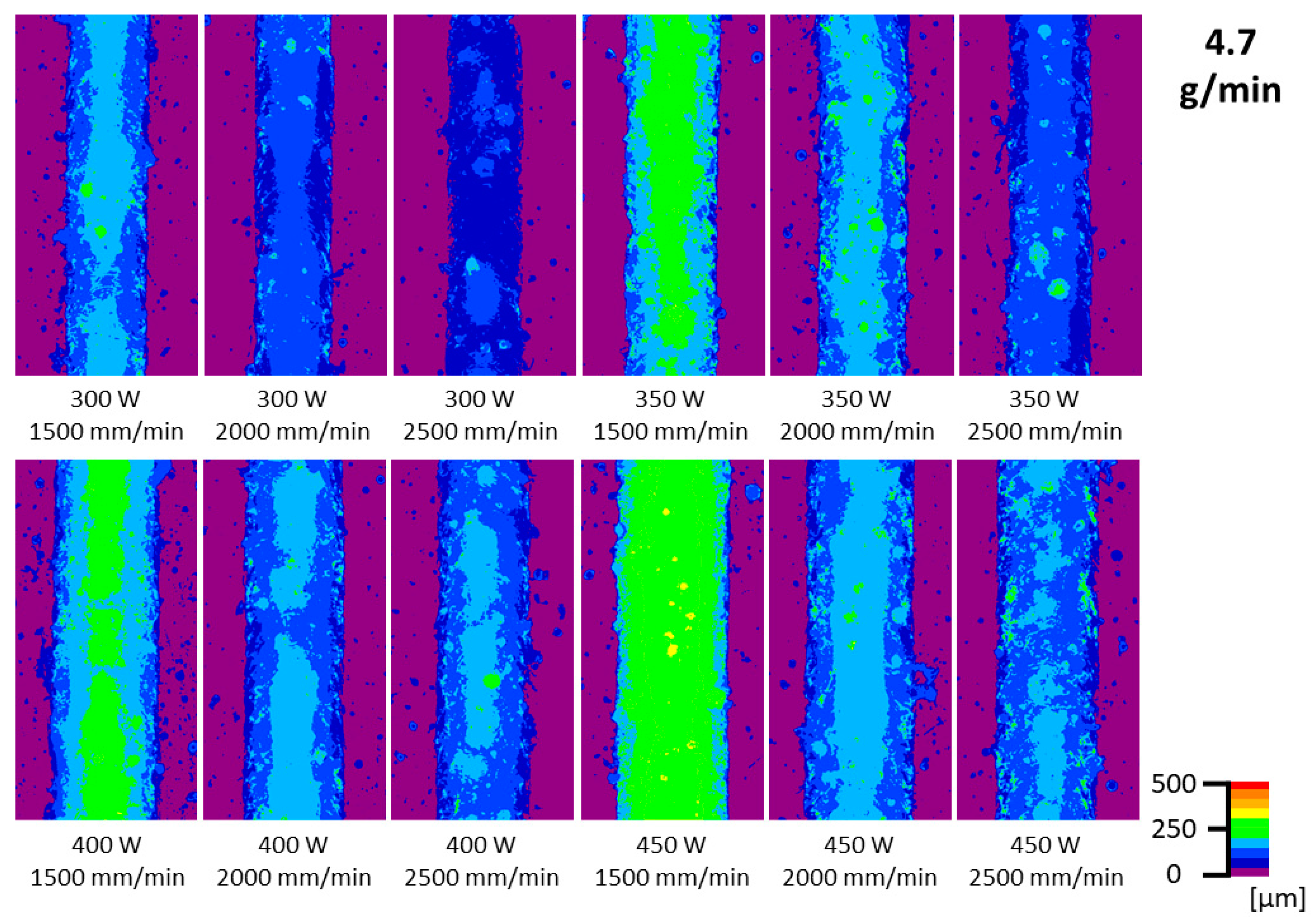
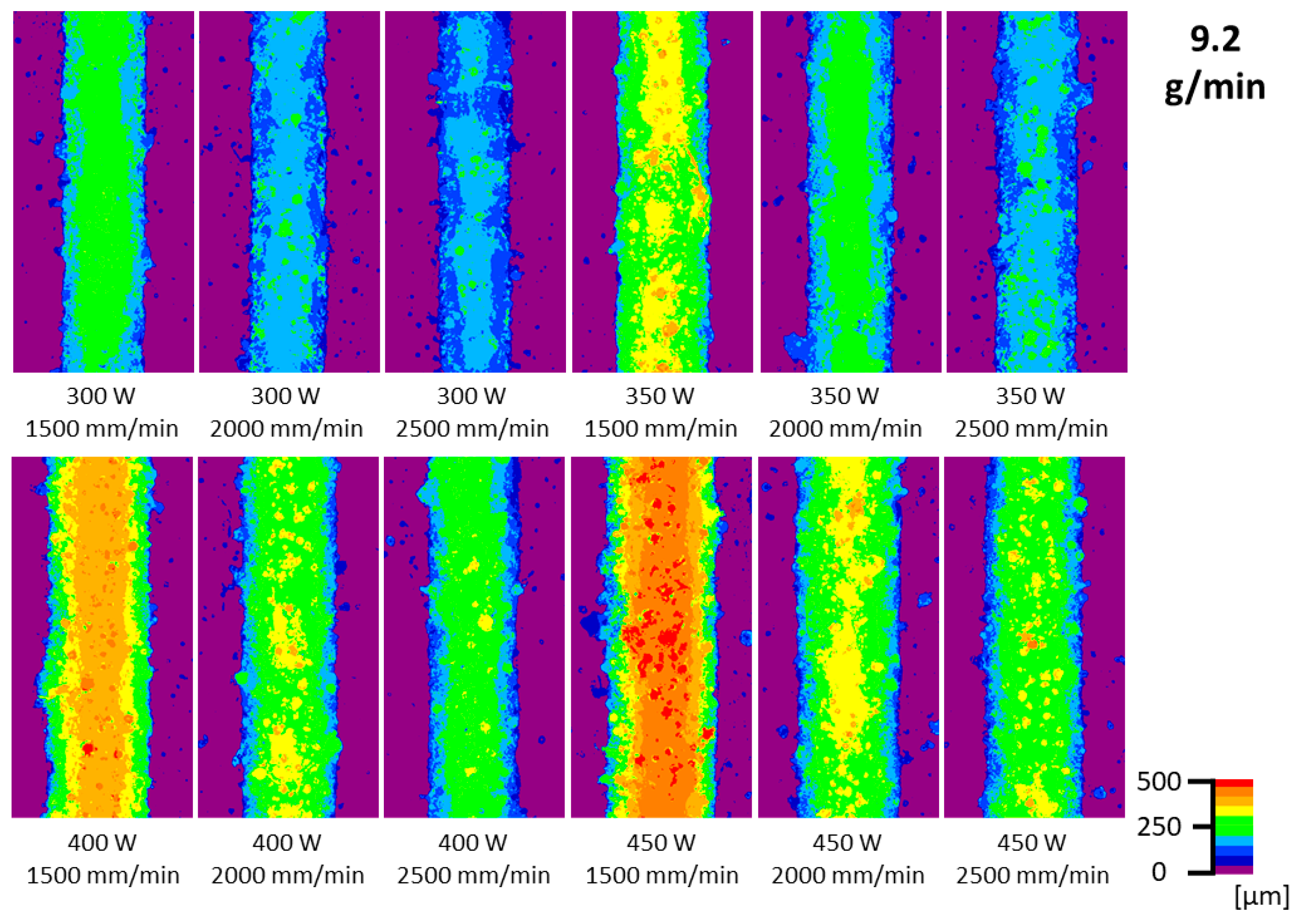
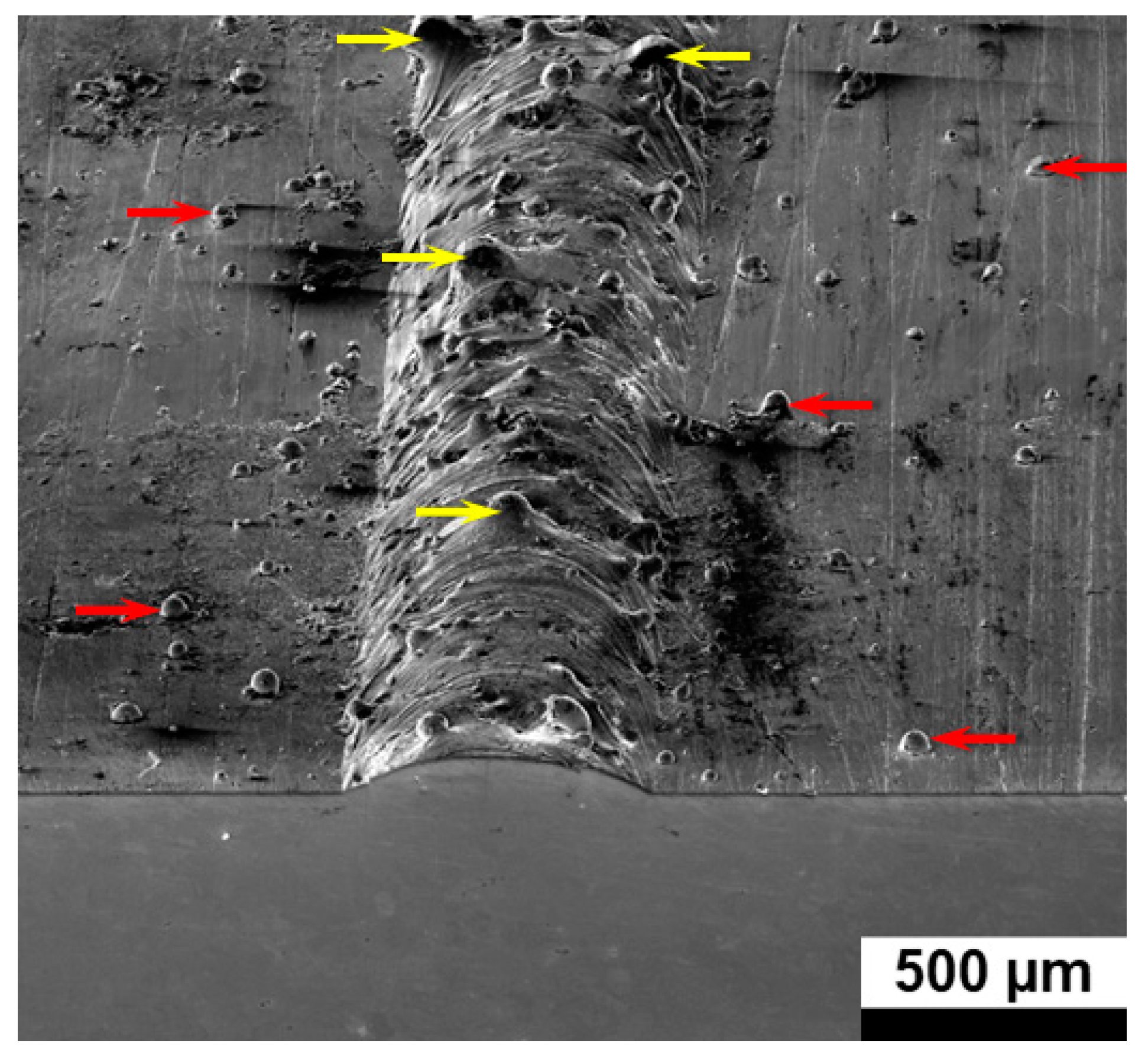
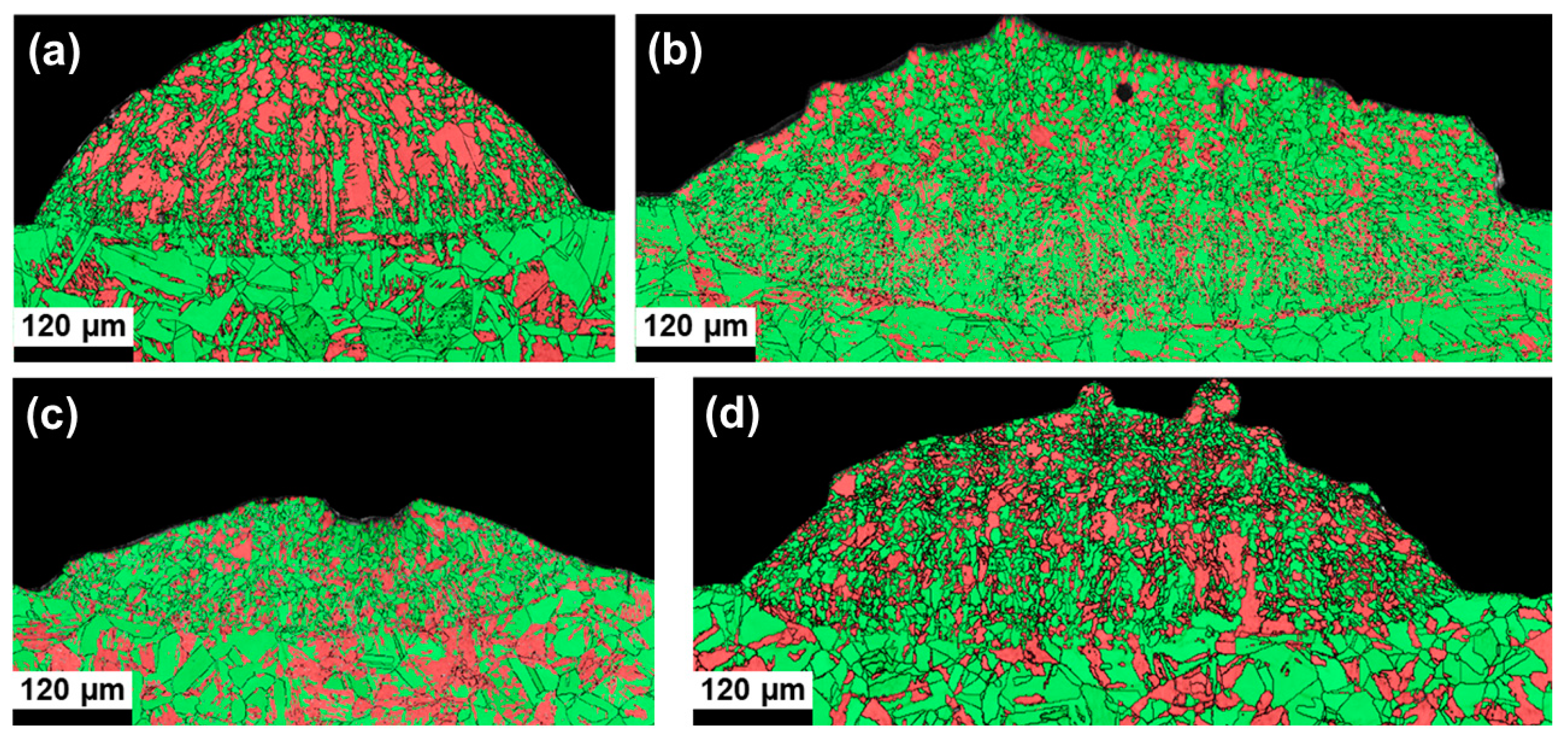

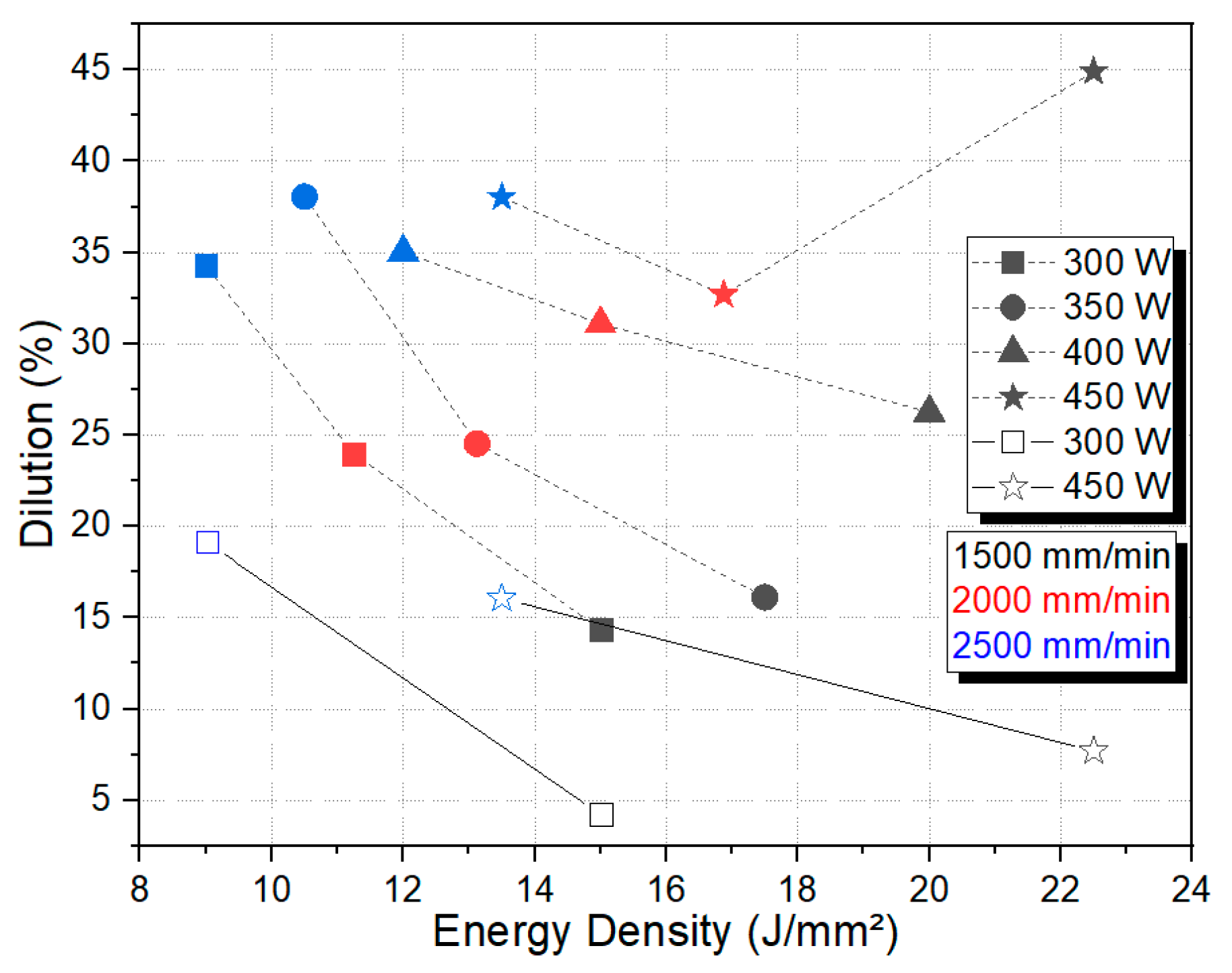
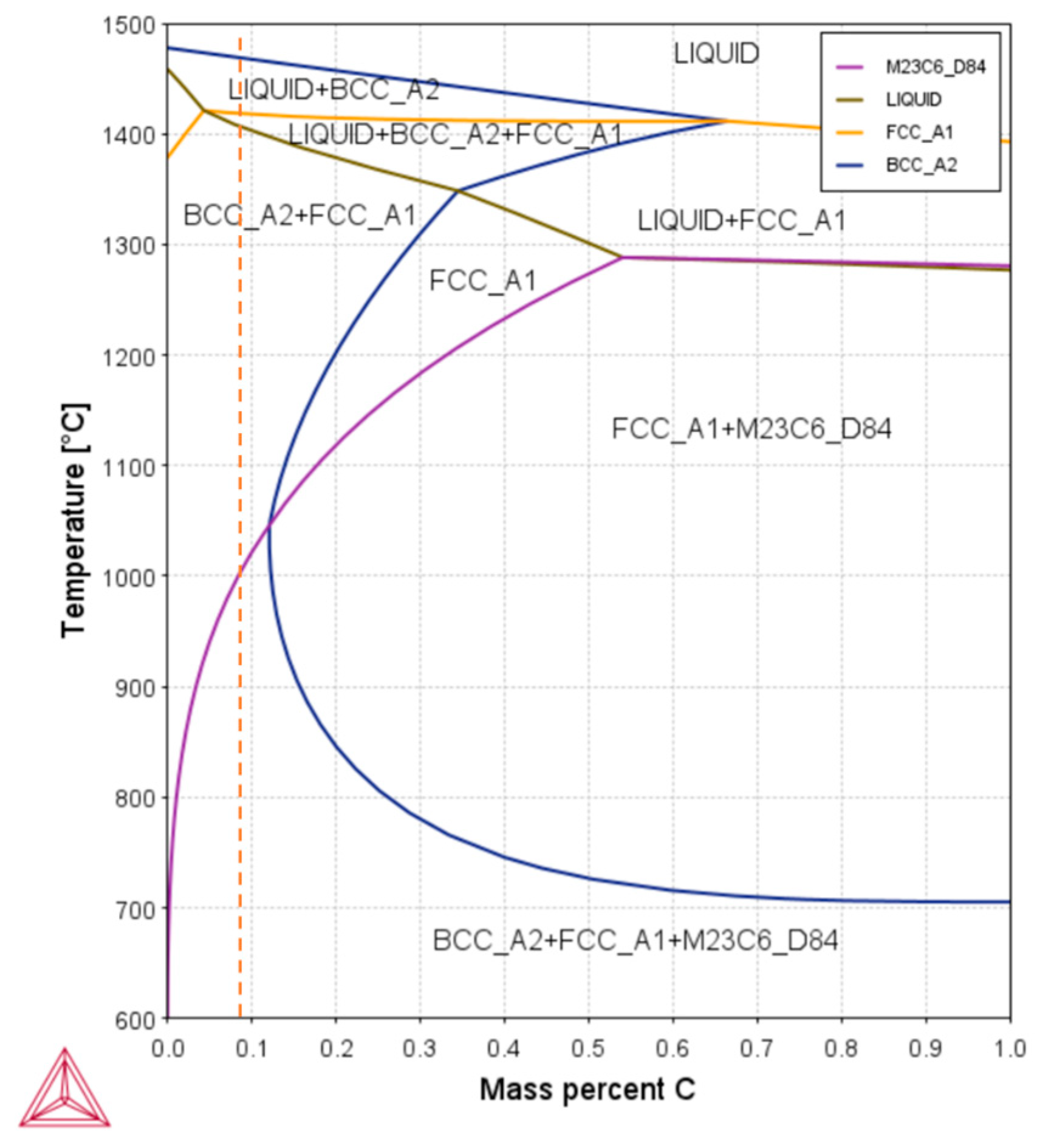

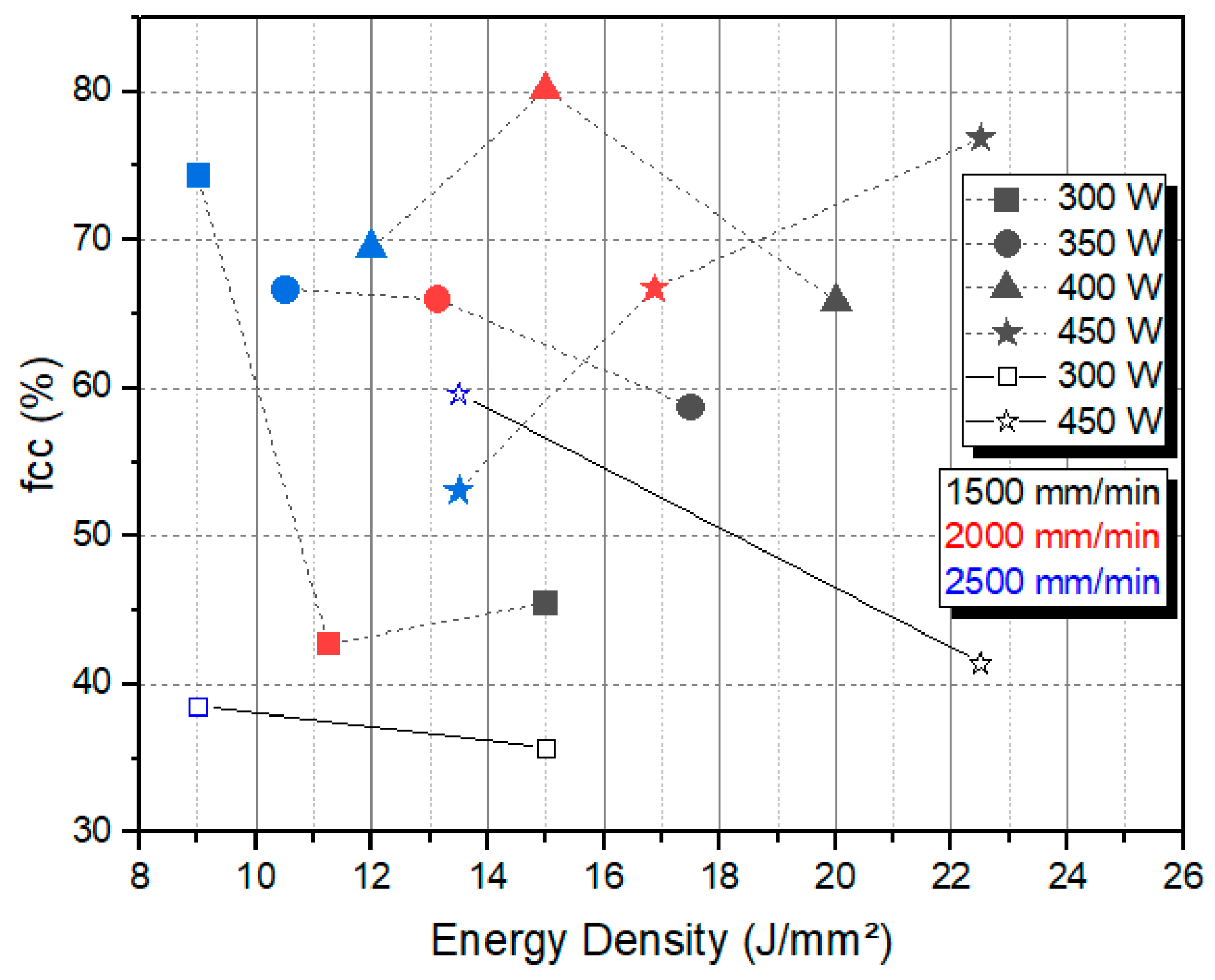
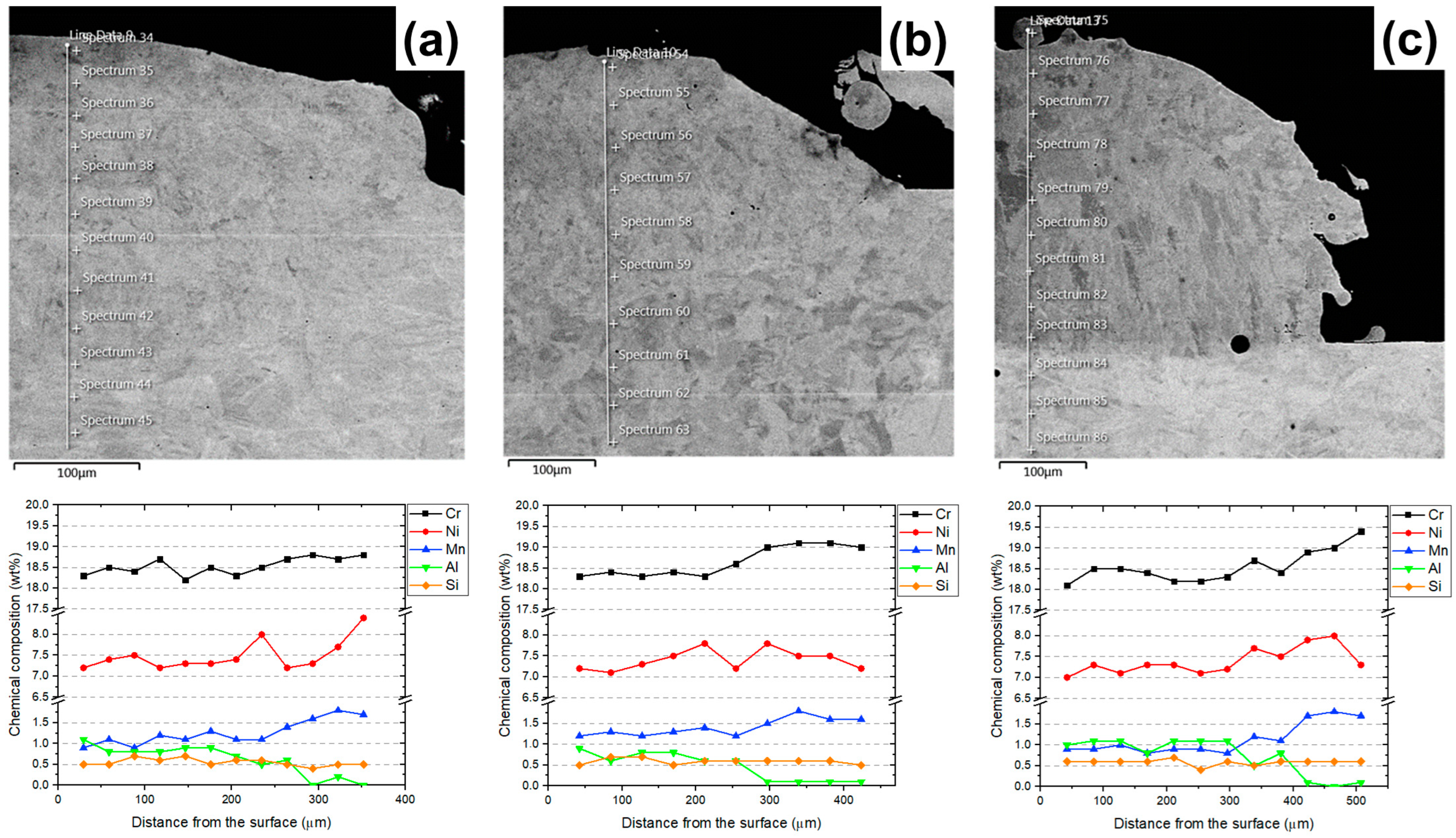
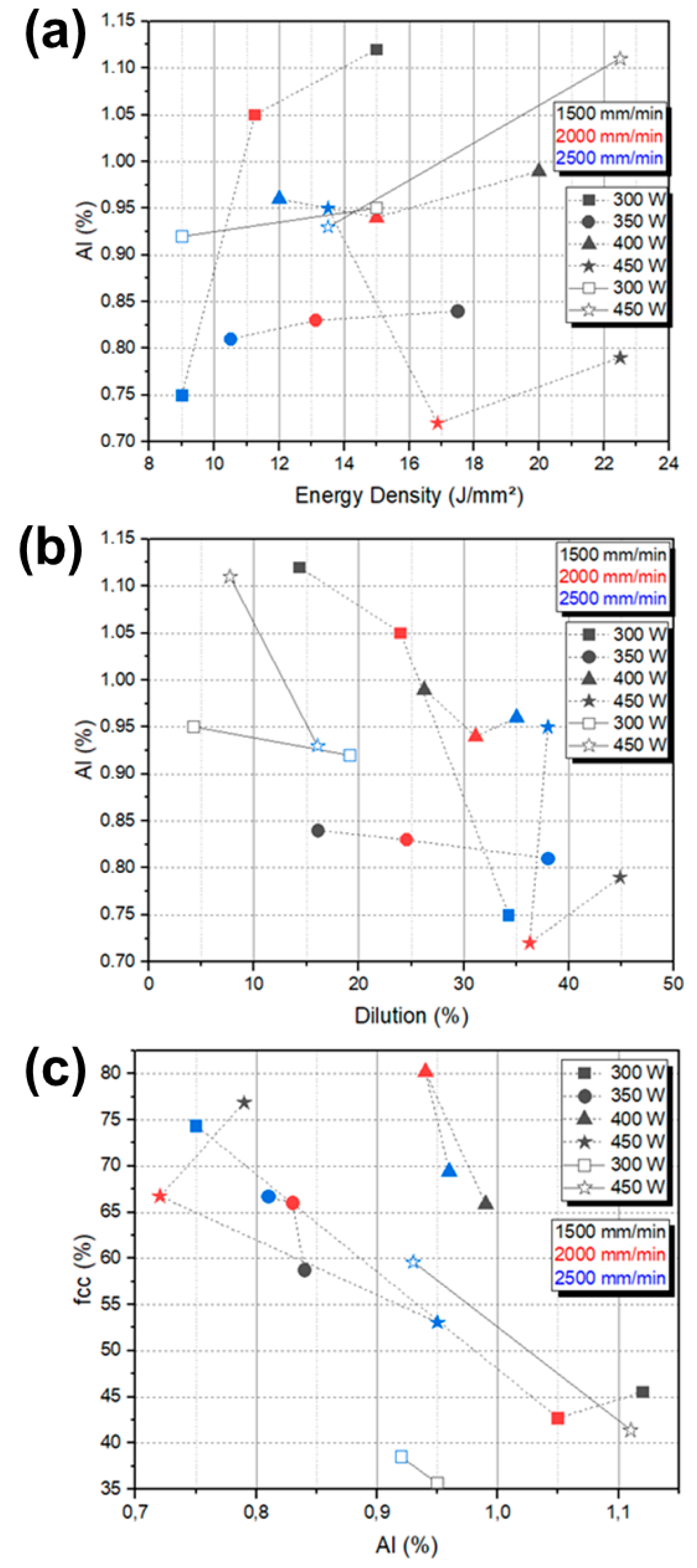
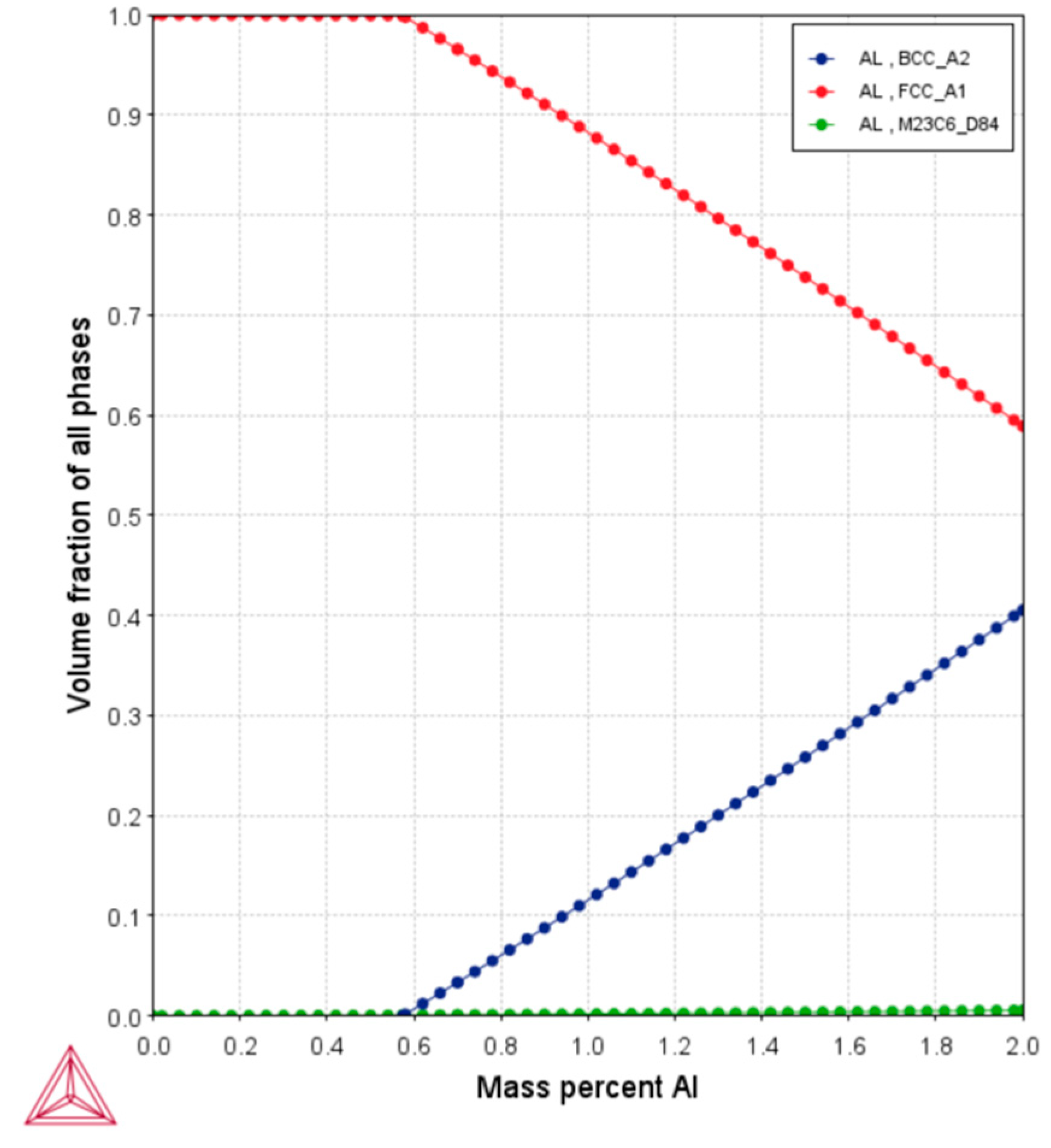

| Scanning Speed (mm/min) | Laser Power (W) | |||
|---|---|---|---|---|
| 300 | 350 | 400 | 450 | |
| 1500 | 15.00 | 17.50 | 20.00 | 22.50 |
| 2000 | 11.25 | 13.12 | 15.00 | 16.87 |
| 2500 | 9.00 | 10.50 | 12.00 | 13.50 |
| Scanning Speed (mm/min) | Laser Power (W) | |||
|---|---|---|---|---|
| 300 | 350 | 400 | 450 | |
| 1500 | 14.3 ± 4.3 | 14.1 ± 4.8 | 14.8 ± 5.0 | 14.2 ± 4.4 |
| 2000 | 14.6 ± 4.1 | 14.5 ± 4.6 | 14.2 ± 4.5 | 14.1 ± 3.9 |
| 2500 | 14.1 ± 4.8 | 14.6 ± 4.9 | 14.6 ± 4.7 | 14.4 ± 4.4 |
| Scanning Speed (mm/min) | Laser Power (W) | |||
|---|---|---|---|---|
| 300 | 350 | 400 | 450 | |
| 1500 | 20.7 ± 5.7 | 20.7 ± 5.9 | 20.9 ± 5.2 | 20.4 ± 5.7 |
| 2000 | 17.1 ± 5.6 | 17.1 ± 5.3 | 16.6 ± 5.4 | 16.7 ± 5.3 |
| 2500 | 16.8 ± 5.4 | 16.6 ± 5.1 | 16.5 ± 5.5 | 16.4 ± 5.4 |
Disclaimer/Publisher’s Note: The statements, opinions and data contained in all publications are solely those of the individual author(s) and contributor(s) and not of MDPI and/or the editor(s). MDPI and/or the editor(s) disclaim responsibility for any injury to people or property resulting from any ideas, methods, instructions or products referred to in the content. |
© 2025 by the authors. Licensee MDPI, Basel, Switzerland. This article is an open access article distributed under the terms and conditions of the Creative Commons Attribution (CC BY) license (https://creativecommons.org/licenses/by/4.0/).
Share and Cite
Barbosa, A.L.; Mariani, F.E.; Pereira, F.M.; Cintho, O.M.; Coelho, R.T.; Gargarella, P.; Zilnyk, K. Directed Energy Deposition-Laser Beam of Semi-Austenitic Precipitation-Hardening Stainless Steel. J. Manuf. Mater. Process. 2025, 9, 114. https://doi.org/10.3390/jmmp9040114
Barbosa AL, Mariani FE, Pereira FM, Cintho OM, Coelho RT, Gargarella P, Zilnyk K. Directed Energy Deposition-Laser Beam of Semi-Austenitic Precipitation-Hardening Stainless Steel. Journal of Manufacturing and Materials Processing. 2025; 9(4):114. https://doi.org/10.3390/jmmp9040114
Chicago/Turabian StyleBarbosa, Alex Lourenço, Fábio Edson Mariani, Fernanda Mariano Pereira, Osvaldo Mitsuyuki Cintho, Reginaldo Teixeira Coelho, Piter Gargarella, and Kahl Zilnyk. 2025. "Directed Energy Deposition-Laser Beam of Semi-Austenitic Precipitation-Hardening Stainless Steel" Journal of Manufacturing and Materials Processing 9, no. 4: 114. https://doi.org/10.3390/jmmp9040114
APA StyleBarbosa, A. L., Mariani, F. E., Pereira, F. M., Cintho, O. M., Coelho, R. T., Gargarella, P., & Zilnyk, K. (2025). Directed Energy Deposition-Laser Beam of Semi-Austenitic Precipitation-Hardening Stainless Steel. Journal of Manufacturing and Materials Processing, 9(4), 114. https://doi.org/10.3390/jmmp9040114






